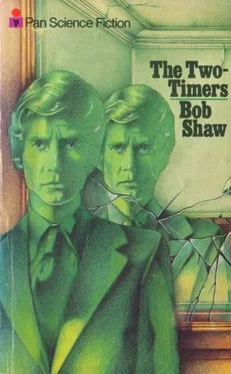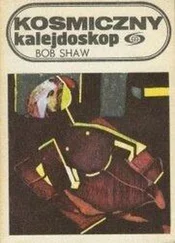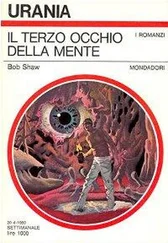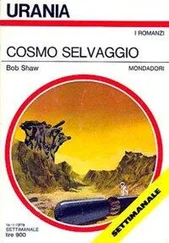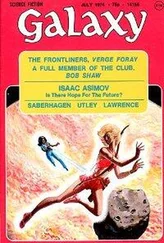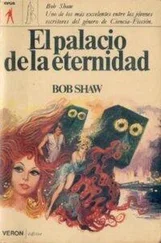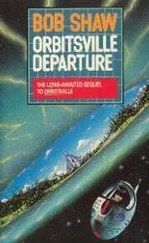Bob Shaw - The Two Timers
Здесь есть возможность читать онлайн «Bob Shaw - The Two Timers» весь текст электронной книги совершенно бесплатно (целиком полную версию без сокращений). В некоторых случаях можно слушать аудио, скачать через торрент в формате fb2 и присутствует краткое содержание. Год выпуска: 1971, Издательство: Pan SF, Жанр: Фантастика и фэнтези, на английском языке. Описание произведения, (предисловие) а так же отзывы посетителей доступны на портале библиотеки ЛибКат.
- Название:The Two Timers
- Автор:
- Издательство:Pan SF
- Жанр:
- Год:1971
- ISBN:нет данных
- Рейтинг книги:5 / 5. Голосов: 1
-
Избранное:Добавить в избранное
- Отзывы:
-
Ваша оценка:
- 100
- 1
- 2
- 3
- 4
- 5
The Two Timers: краткое содержание, описание и аннотация
Предлагаем к чтению аннотацию, описание, краткое содержание или предисловие (зависит от того, что написал сам автор книги «The Two Timers»). Если вы не нашли необходимую информацию о книге — напишите в комментариях, мы постараемся отыскать её.
THE TWO-TIMERS is his third novel, but the first to achieve maior publication.
The Two Timers — читать онлайн бесплатно полную книгу (весь текст) целиком
Ниже представлен текст книги, разбитый по страницам. Система сохранения места последней прочитанной страницы, позволяет с удобством читать онлайн бесплатно книгу «The Two Timers», без необходимости каждый раз заново искать на чём Вы остановились. Поставьте закладку, и сможете в любой момент перейти на страницу, на которой закончили чтение.
Интервал:
Закладка:
And at intervals of six or seven days he made trips, always to that final scene with Kate. Sometimes the elm trees would be so translucent as to be almost nonexistent; at other times they reared up black and real, giving him the impression he would be able to see two figures moving at their bases were it not for the overlaid light of store windows and automobile headlights.
With the continued in-growing of his perceptions, he became more aware of the phenomena he had learned to identify as preludes to the trips. There would be the gradual intensification of his nervous activity, leading him to think he had escaped from despair as it culminated in a heady sense of well-being. Close on that came the first visual disturbances, starting with a furtive glimmer and spreading all over his right eye. As soon as it began to abate, reality shifted — and he was back in the past
The discovery that the visual phenomena were familiar to others surprised Breton, because as a boy he had attempted to describe them to his friends and had never achieved any reaction. Even his parents had shown nothing more than indulgent mock-interest and he had never been able to convince them he was not talking about afterimages caused by bright lights. He had learned not to talk about the trips or anything associated with them, and over the years the conviction had grown on him that his experience was unique, private to Jack Breton. But the chance conversation with Harry Calder had changed all that; and the interest it had stirred in him was the only genuine stake he had in the bleak, bitter present
Breton began spending his afternoons in the public library, aware he was following an idea beside which his former fantasy about Kate’s murderer was a working blueprint, but unable to ignore its feverish pounding in his mind. He read the scanty literature on migraine, then went on to general medical works, biographies of famous migraine sufferers, anything his instincts told him might lead in the direction he wanted to go. Never having connected himself with migraine before, Breton had a vague idea it was a recent product of high-pressure civilization. His reading showed him it had been known to ancient cultures, one of them that of the Greeks, who had named it hemicrania — the hall-headache. In the great majority of cases, the visual disturbances were followed by severe headaches affecting one side of the head, then nausea. Some people were lucky enough to escape one or other of these symptoms, and there was a rare category of individual who avoided both. Their condition was known as hemicrania sine dolore.
One of the most intriguing things, as far as Breton was concerned, was the amazing exactness with which his own visual experiences had been described by other men in other times. The medical terms were various — teichopsia, scintillating scotoma — but the one he preferred for its aptness was “fortification figures.” It had first been used by an 18th century doctor, John Fothergill, who had written:
“… a singular kind of glimmering in the sight, objects swiftly changing their apparent position, surrounded by luminous angles like those of a fortification.”
Fothergill had attributed it to eating too much buttered toast at breakfast time — an explanation Breton found only slightly less satisfactory than up-to-the-minute theories which spoke vaguely about temporary irritations of the visual cortex. One dark brown afternoon, when he and the others in the old building were sitting quietly like objects in the bottom of a petrifying well, he turned the pages of an obscure health magazine and was chilled to find accurate drawings — not of the fortification figures, which would have defeated any artist — but of the black star which sometimes appeared in their place.
One of the drawings was by the French philosopher, Blaise Pascal, and another had been done as far back as the 12th century by Abbess Hildegarde of Bingen.
“I saw a great star,” the Abbess had written, “most splendid and beautiful and with an exceeding multitude of falling sparks with which the star followed southwards… and suddenly they were all annihilated, being turned into black coals and cast into the abyss so that I could see them no more.”
Breton read on quickly but, as was the case with all the other recorded accounts, there was no mention of a subsequent vision of the past. In that respect, it appeared, he really was unique.
A year later Breton pedantically wrote in his notebook:
“I now incline more than ever towards the theory that all migraine sufferers are frustrated time travelers. The power which provides temporal motivation is the desire to return to the past, possibly to relive periods of extreme happiness, but more probably to correct mistakes which are seen in retrospect to have had a malign effect on the course of events.
“Prior to Kate’s death my own case was a freakish example of someone who almost could go back, not because of greater motivation, but though a lower threshold, a chance configuration of the nervous system. (The visual disturbances may be caused by some degree of temporal displacement of the retina — which is, after all, an extension of the brain, and therefore the sense organ most intimately associated with the activity of the central nervous system.)
“Since Kate’s death my retroactive potential has reached an abnormally high level, resulting in frequent trips. Leaving aside the problem of constructing a philosophical edifice capable of accommodating the physical implications, the question remains of how to put theory into practice. Ergotamines, methysergide, diuretics — all these things are in use to minimize the effects of hemicrania, which is hardly what I have in mind…”
And after five years:
“The monthly check from Hetty arrived today. It was larger than usual, making it possible for me to clear my account at the Clermont Scientific Company — which was a relief. I have no wish to impair my credit rating with them at this stage, although I still have the house in reserve and its capital value has appreciated considerably. (What a good idea it was for me to assign formal control of my business to Hetty and that new man Tougher. My only worry is a nagging suspicion that she sometimes augments my check with money of her own.)
“There is some cause for excitement today. My work has finally passed from the investigatory to the constructively experimental stage. I could have reached this point sooner but for following several false trails. All of them were suggested by Dr. Garnet at the migraine clinic, and I am glad my association with that organization is coming to an end. Prodromal symptoms and cerebral blood flow, response to various drugs, metabolism of the amines — red herrings, the lot of them. (As far as my work is concerned, anyway. I must not be too unkind to Garnet.)
“To think that my big breakthrough came as a result of using a badly designed screwdriver!
“I don’t know what prompted me to withdraw the fluid from that huge blister on the palm of my right hand, unless it was that I had been thinking a lot about the possible use of hemicranial pain as a trigger mechanism to augment chronomotive impulses. Work at the clinic had established that a substance called kinin was produced in the region of the head arteries during migraine attacks in people not fortunate enough to be afflicted with hemicrania sine dolore.
“Blister fluid itself does not cause pain, but I have proved that when it is withdrawn and put in contact with glass it develops kinin, which — when put into the blister again — certainly does cause pain. By injecting kinin at the first onset of teichopsia heralding my last three trips I was able to experience genuine hemicrania, and — for the first time — I heard those three elm trees moving in the wind!
Читать дальшеИнтервал:
Закладка:
Похожие книги на «The Two Timers»
Представляем Вашему вниманию похожие книги на «The Two Timers» списком для выбора. Мы отобрали схожую по названию и смыслу литературу в надежде предоставить читателям больше вариантов отыскать новые, интересные, ещё непрочитанные произведения.
Обсуждение, отзывы о книге «The Two Timers» и просто собственные мнения читателей. Оставьте ваши комментарии, напишите, что Вы думаете о произведении, его смысле или главных героях. Укажите что конкретно понравилось, а что нет, и почему Вы так считаете.
